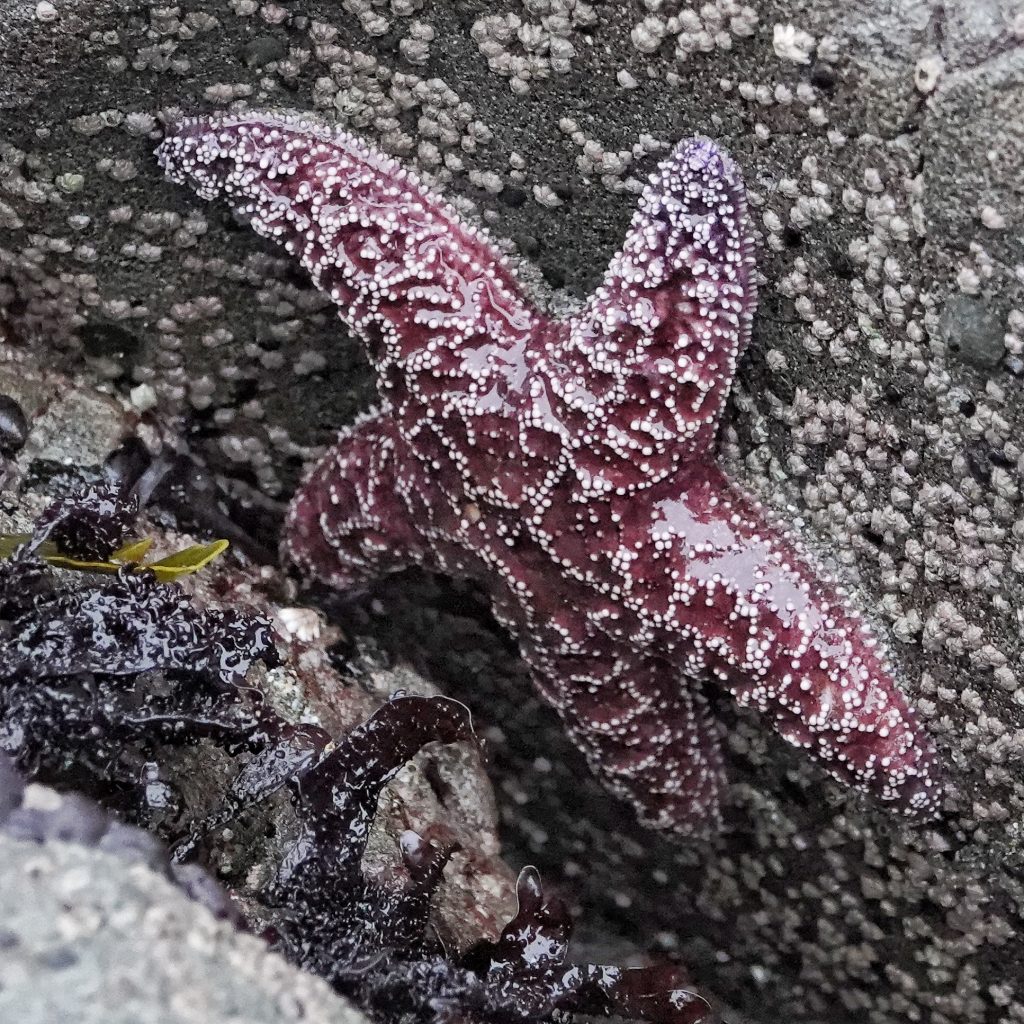
For me Pisaster ochraceus, with their bright colors, tenacious clinging to the rock, and utterly alien lifestyle (by that I mean that here is an animal that never appears to be moving but is one of the most unstoppable predators in its environment, and yet is apparently impervious to all predators except gulls, sea otters, and humans with prying tools), epitomize what makes tidepools so fascinating. Variously called purple sea star, ochre sea star, or ochre starfish, they are members of a new phylum for this website, Echinodermata, which includes such marine invertebrates as sea stars, brittle stars, sea cucumbers, sea urchins, sand dollars, and crinoids.
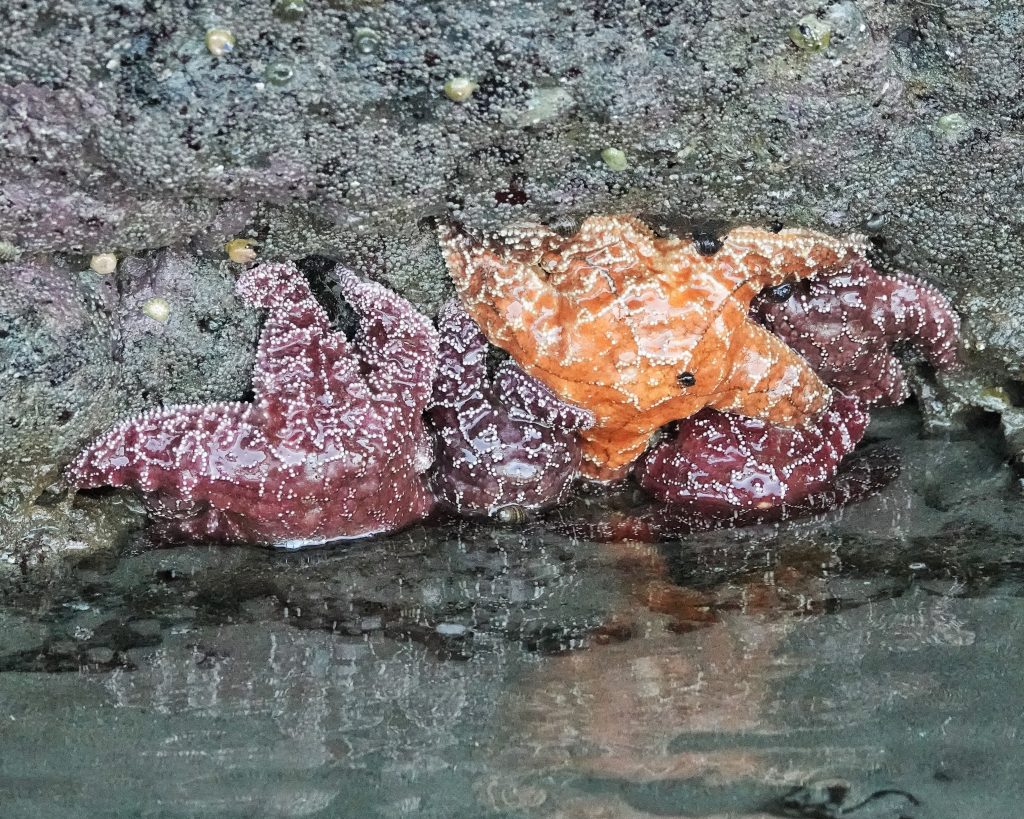
These wonderful creatures are considered to be a keystone species (in fact it was the relationship of Pisaster ochraceus to the mussels of the intertidal zone that led Robert Paine to coin the concept of a keystone species in his 1969 paper “A Note On Trophic Complexity and Community Stability”) because of their ability to control the extent to which mussels (and other sessile creatures like acorn and gooseneck barnacles) can proliferate over the rocks, and to alter the feeding patterns and population demographics of the plentiful, alga feeding snail Tegula funebralis. Sea stars have a very unusual way of feeding. After they use their suction cup equipped arms to spread open the shell of the mussel (or pull apart the plates of barnacles, or detach snails, whelks, limpets, or chitons from their perch), they evert their stomach through their mouth, disgorge digestive enzymes upon the food source, and keep their stomach wrapped around it until they have absorbed all of the nutrients, at which time they retract their stomach inside their body and set off very slowly to find their next victim.
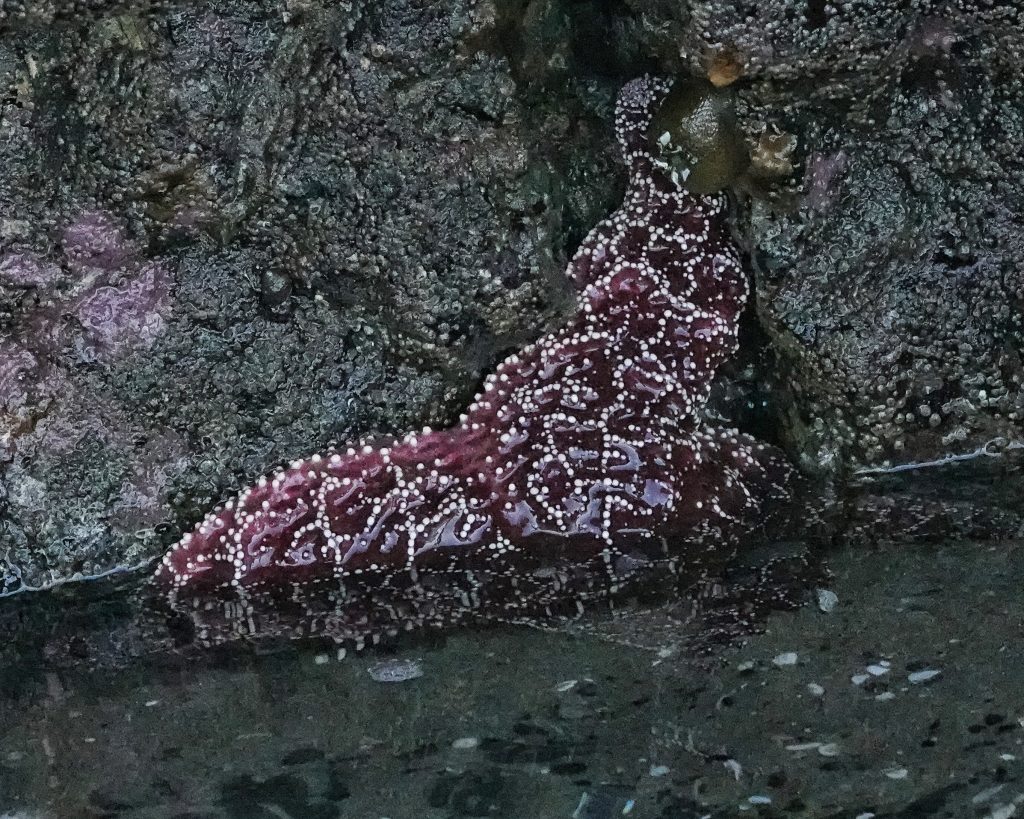
Pisaster ochraceus does not do well in higher temperatures, and feeding and growth rates drop significantly at temperatures above 73⁰, with death occurring at 95⁰. To help them avoid these extremes they are very sensitive to light, and will move away from exposure. It has been found that, at least in Barkley Sound, BC, they move with the tide, and don’t travel to the higher elevations of the intertidal zone when low tides happen in the middle of the day, which gives them room to retreat from exposure, but deprives them of some of their better hunting grounds.
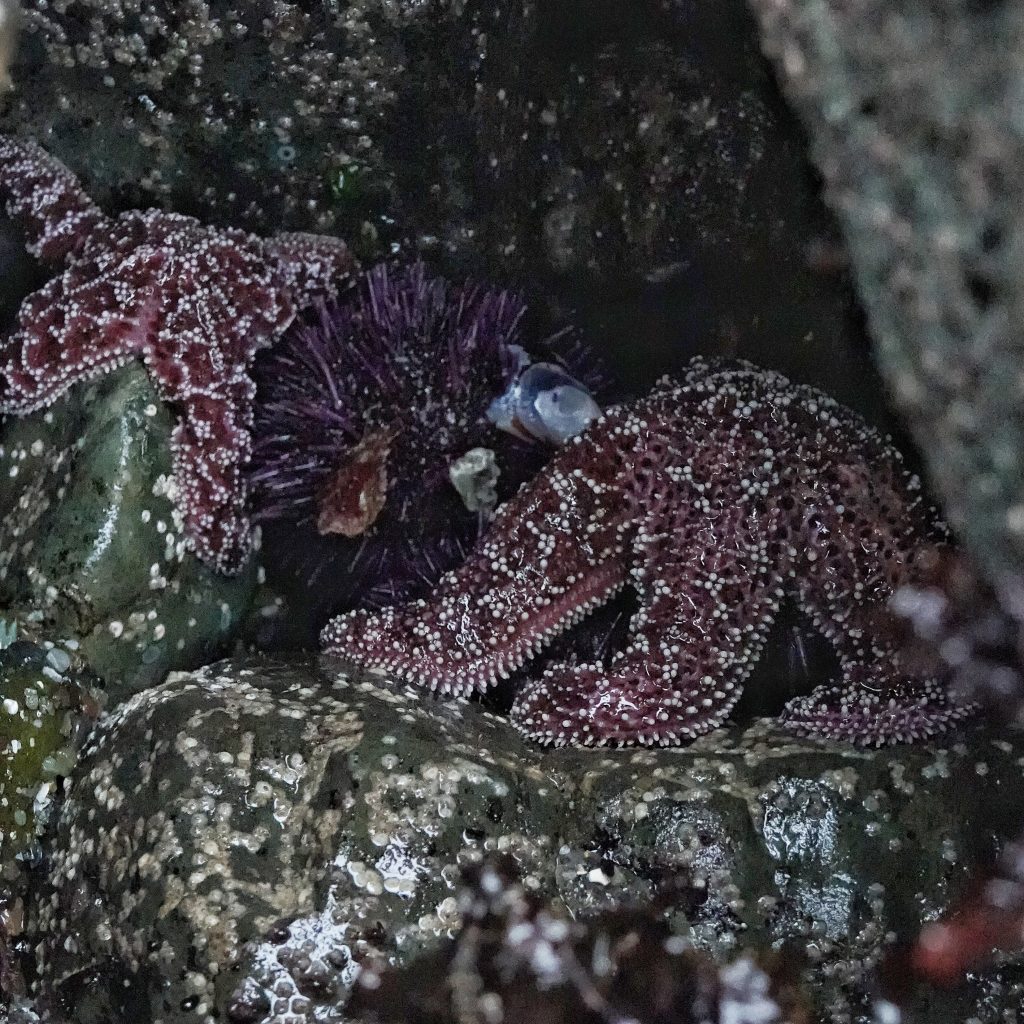
Although the bulk of their reproduction occurs by sexual broadcast spawning, some Pisaster ochraceus larvae in their bipinnaria stage may release a bud or split apart to form a clone. This appears to be a response to high concentrations of phytoplankton where the larvae were growing extremely quickly. These sea stars can also regenerate lost limbs, although it is not a quick process, but adults of this species do not reproduce by autonomy (self severing of a limb) like some members of the Hawaiian genus Linckia. For more information on the ecology and life history of this species, see the University of Oregon page on Pisaster ochraceus, or chapter 16 in “Starfish: The biology and ecology of the Asteroidea” (Robles; 2013).
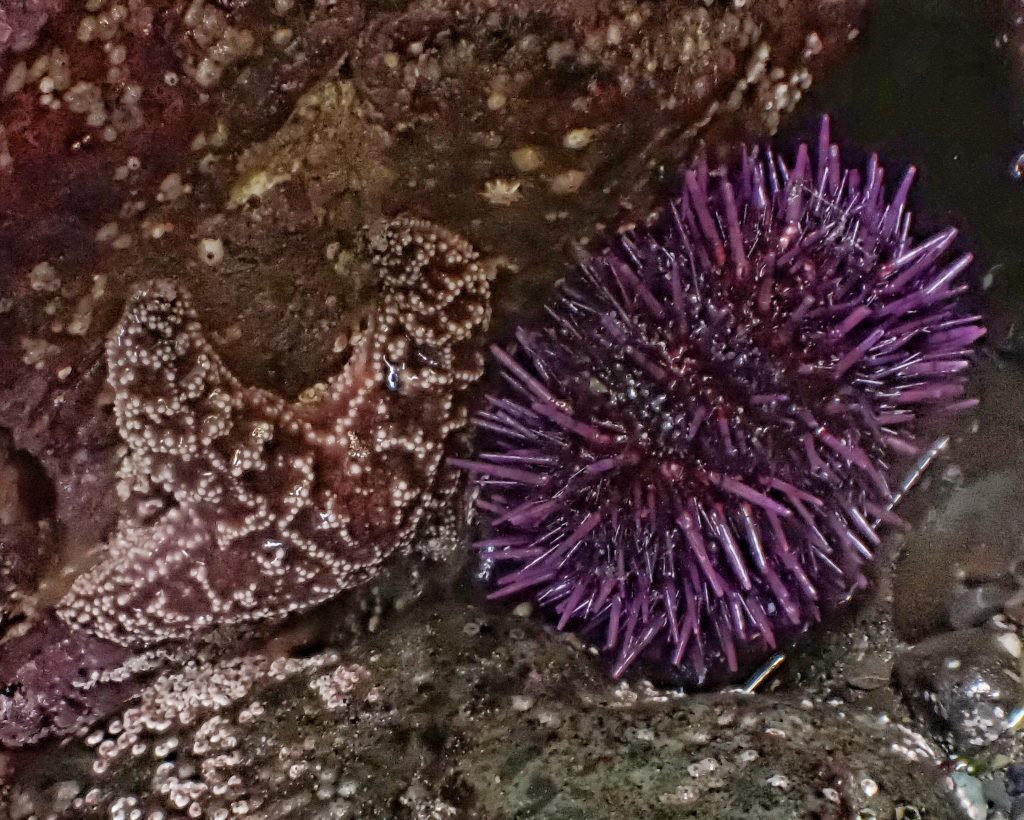
Sea stars (and other Echinodermata) have tiny pincer-like growths on their dorsal surface (called the aboral surface in sea stars, to distinguish from the oral surface, where the mouth is located, which would normally be called the ventral surface) called pedicellariae, which work to prevent parasites and sessile animals from gaining purchase. According to Ricketts in “Between Pacific Tides”, if you rest the aboral surface against your skin for a few seconds, then pull it away, the “…almost microscopic pincers will have attached themselves to the epidermis, and you will feel a distinct series of sharp nips.” Gotta do this the next time I find one of these amazing creatures!
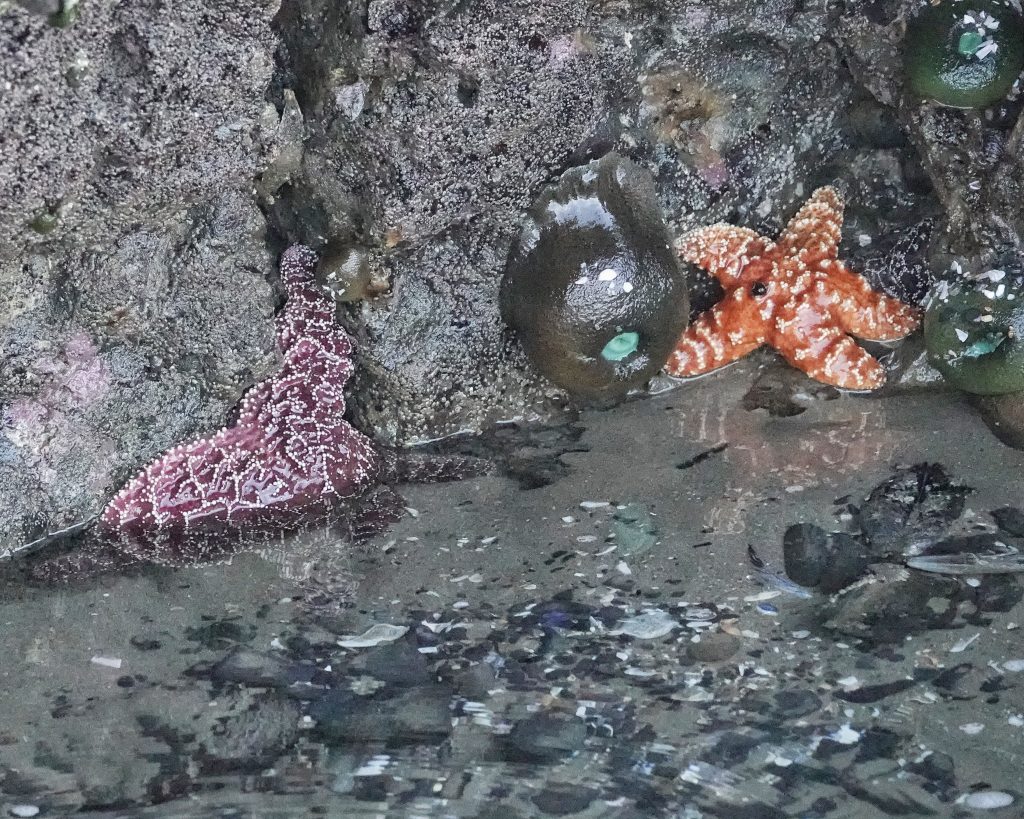
I had a hard time finding Pisaster ochraceus on my recent trip to the Oregon coast, because their numbers have been decimated by Sea Star Wasting Syndrome (SSWS), which may have killed 75% of the members of all species (with the exception of Henricia leviuscula, Dermasterias imbricata, and a few others, which appear to be relatively unaffected) of sea stars in our region (in fact all along the Pacific coast of North America) from 2013-15, and continues to be a problem today, albeit a much less catastrophic one. Outbreaks of SSWS have happened in the 70s, 80s, and 90s, but were much less devastating and widespread. There is still no absolute consensus on what causes SSWS (and nothing has been found that would associate SSWS with the tragedy at the Fukishima nuclear plant in Japan in March, 2011), which causes white lesions, twisting of arms, body and arm deflation, arm loss, body disintegration, and finally death, but according to a study (Aquino et al.; 2021) SSWS is at least exacerbated by heavy microbial growth on and near their epidermis (sea stars take in oxygen via tiny gills on their skin called papulae) which depletes the oxygen in those areas. These explosions in the populations of bacteria called copiotrophs are fueled by warmer waters and excesses of nutrients in the water (often anthropogenic in origin), and only get worse as the sea stars begin to decay. They are, in essence, asphyxiating, though there may be oxygen rich water just millimeters above them. For more on this disease see the study cited above, the MARINe site from UC Santa Cruz, or the National Park Service page on SSWS.
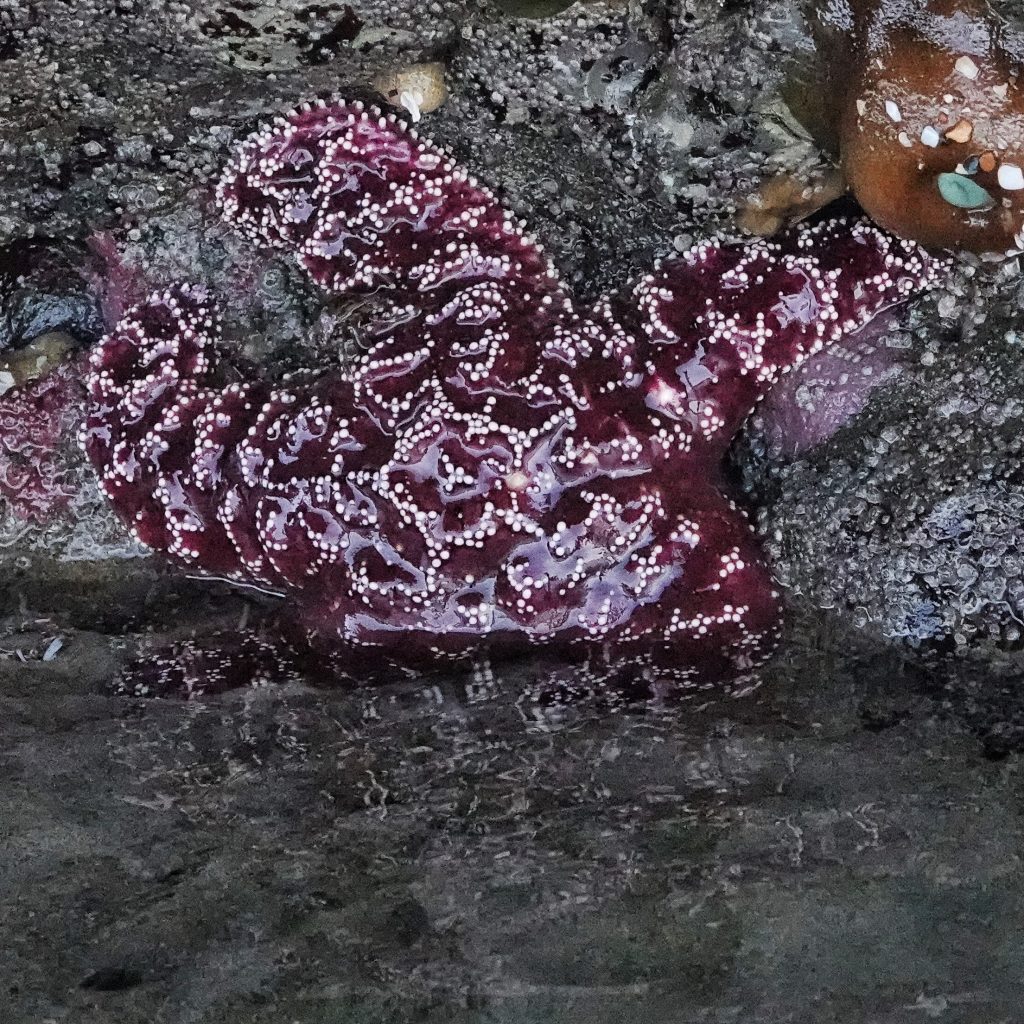
However, their is hope. When I first heard about this in the summer of 2015 it was because several hours of tidepool wandering had produced zero Pisaster ochraceus, thus prompting me to ask the biologist at Cape Perpetua SP ‘what the heck is going on?’ The prognosis wasn’t good at that time. But, thanks to above average recruitment, the numbers are rebounding for this wonderful, emblematic, keystone species of the intertidal zone. There is so much to say and to learn about these creatures (that old Police song ‘Too much information’ kept running through my head as I researched this), and it is beyond my scope to offer more than this brief overview. I sincerely hope I’ve piqued your curiosity enough that you’ll check out some of the links I’ve provided.
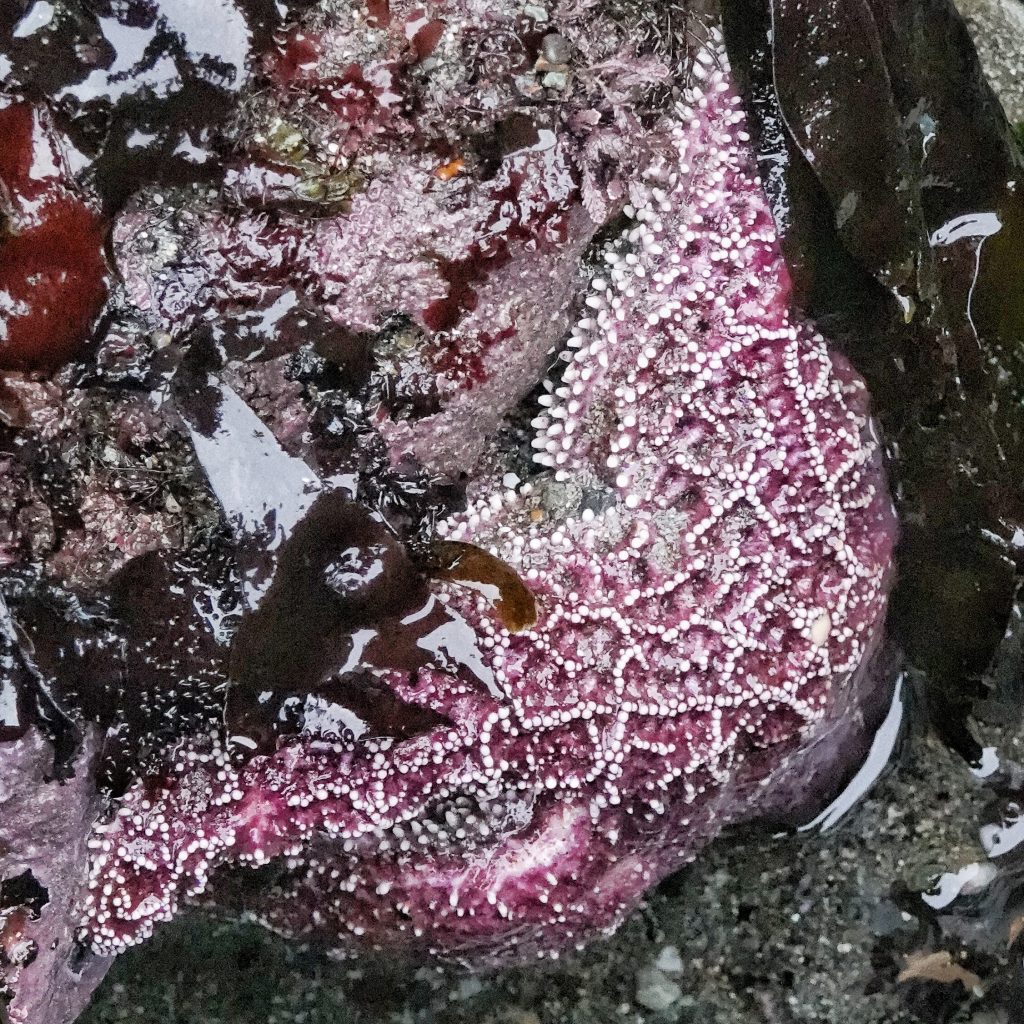
Description-Medium to large sized (may be up to 20” in diameter) orange, ochre, yellow, purple, or blue sea star, with 5 (sometimes 4-7) continually tapering arms that are only slightly longer than the diameter of the disk, and white spines forming a reticulate (net like) pattern over the whole upper surface.
Similar species–Pisaster brevispinus is usually pink, and has small spines; P. giganteus has blue rings around white or purple spines; Evasterias troscheli has greater arm-to-disk ratio, the arms are often thickest some distance from the base, and the spines are not in a reticulate pattern.
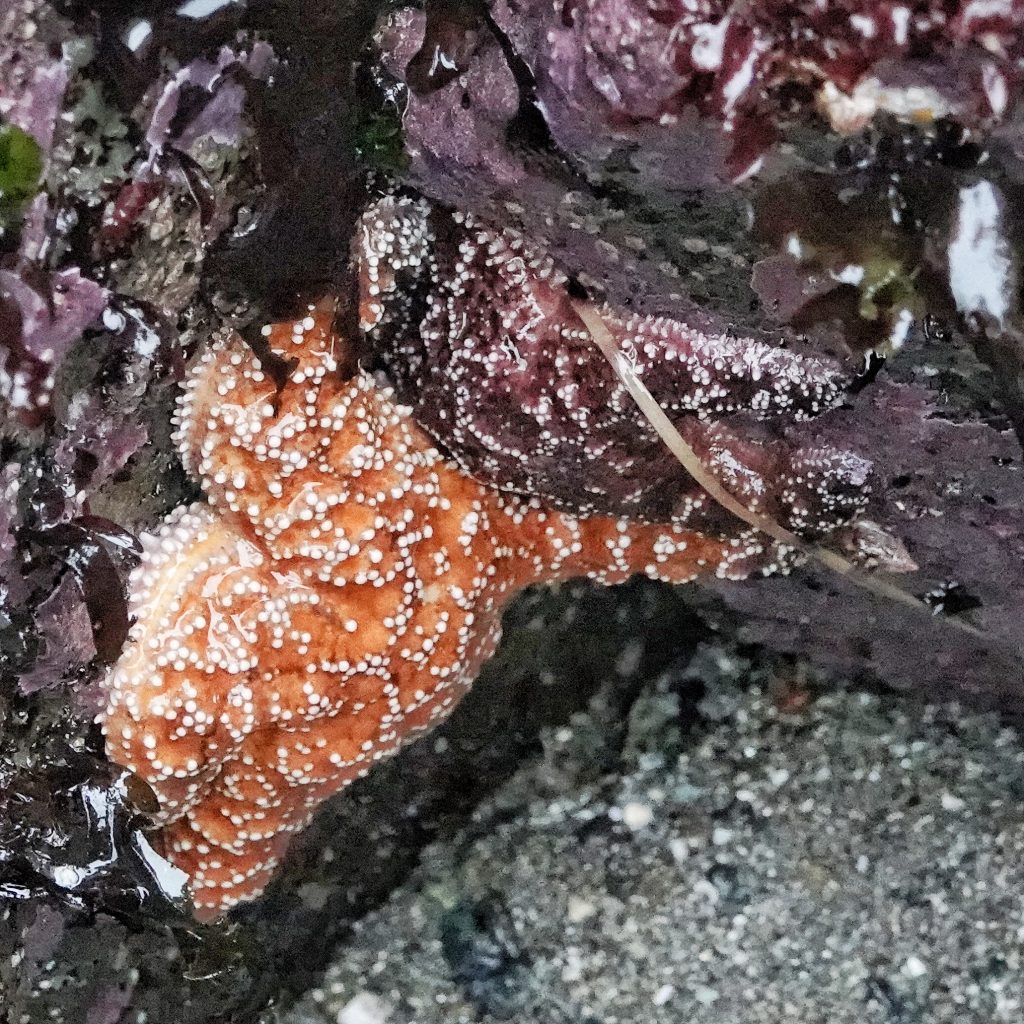
Habitat-Rocky mid to low intertidal areas, and down to 300’ below the surface.
Range-Pacific coast from Prince William Sound in Alaska, to Cedros Island in Baja.
Eats-Primarily mussels when available, but also feeds on barnacles, snails, whelks, limpets, and chitons, as well as occasionally attacking purple sea urchins; Pisaster ochraceus exudes a chemical signature that prey species can ‘smell’, and those that can move away (snails often just detach from the substrate and roll out of the way) will do so
Eaten by-Gulls and sea otters; the sea star Pycnopodia helianthoides may prey upon this species, since it is a known predator of other Pisaster, but this has not been confirmed.
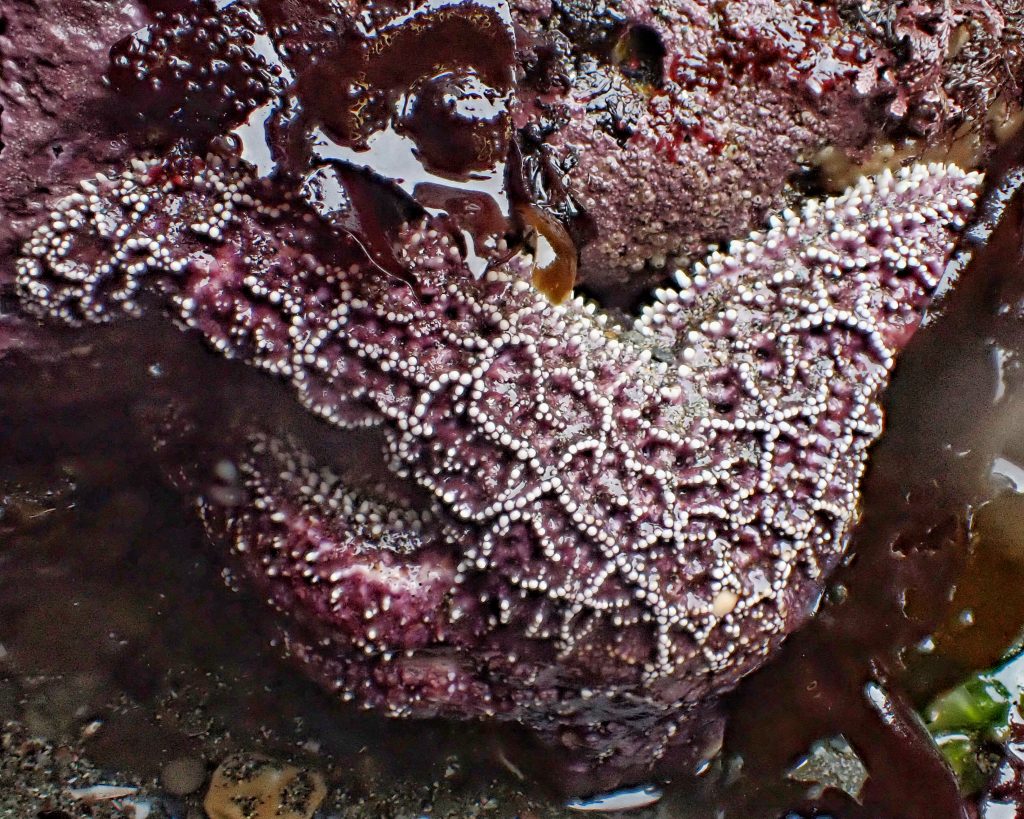
Adults active-Year around, although they are less active from November to March in our region, and retreat to the lower intertidal areas to avoid freshwater runoff, strong winter storms, and low tide freezes.
Life cycle– Broadcast spawners; spawning may take place from late April through August, depending on latitude, with spawn timing being later the farther north you go; within 7 days the eggs hatch into free swimming bipinnaria larva, and eventually (timing apparently being dependent on food resources) they develop three arms and enter the brachiolaria stage, which only lasts until they settle onto a substrate, at which time the metamorphose into juveniles that look like miniature adults; the entire process from fertilization to juvenile takes from 36-228 days; sexual maturity is reached in about 5 years; may live up to 20 years
Etymology of names–Pisaster is from the Greek words for ‘pea star’, and I cannot ascertain the specific meaning beyond the obvious reference to their star shape, and pea often indicating that something is small. The specific epithet ochraceus is from the Latin word for ‘ochre colored’, referring to one of the common colors of this species.
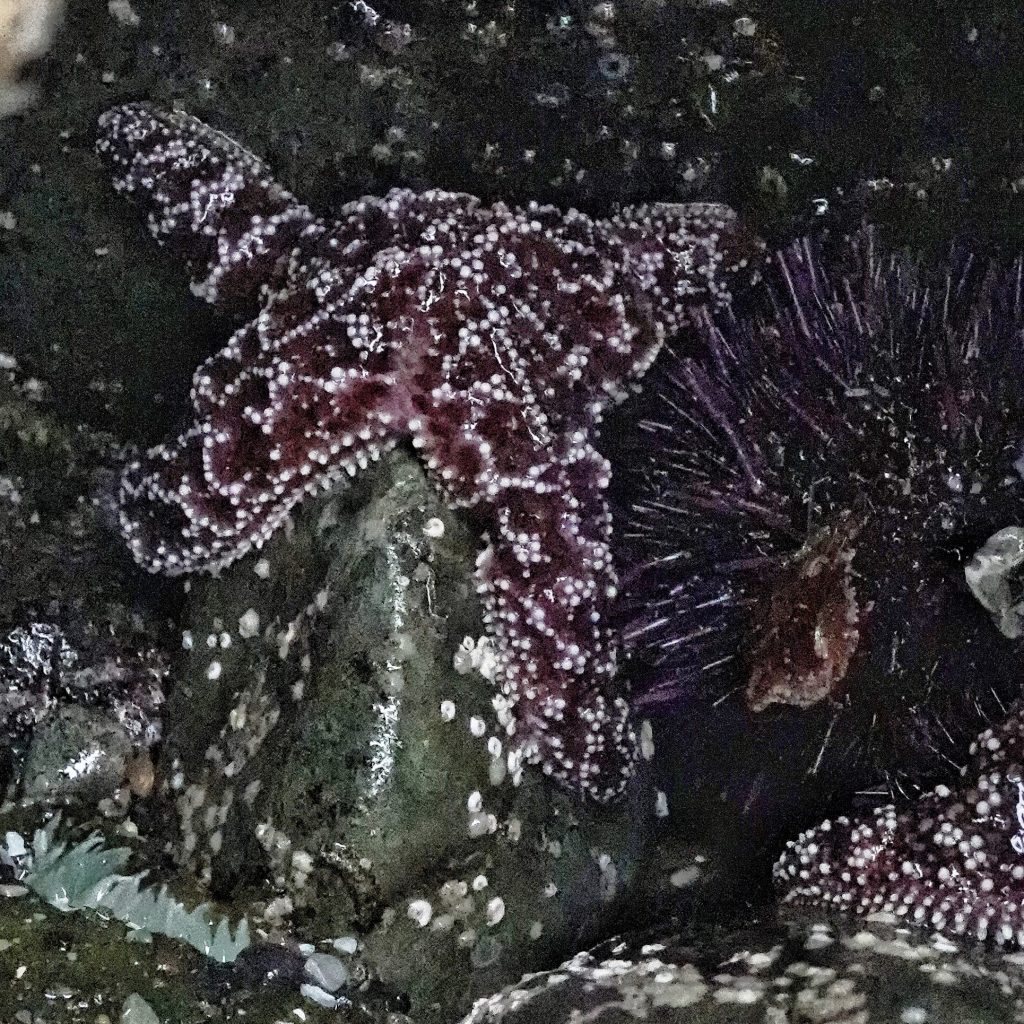
https://oimb.uoregon.edu/wp-content/uploads/2019/03/P_ochraceus_2019.pdf
https://beta.nsf.gov/news/organic-matter-bacteria-doom-sea-stars-oxygen
Sea Star Wasting Syndrome | MARINe
Sea Star Wasting Syndrome (U.S. National Park Service)
Sci-Hub | Feeding Behavior and Reproductive Cycles in Pisaster ochraceus | 10.2307/1539653
https://www.int-res.com/articles/dao2009/86/d086p245.pdf
Ochre Sea Star · University of Puget Sound
https://www.jstor.org/stable/1540668
Sci-Hub | A Note on Trophic Complexity and Community Stability | 10.1086/282586
https://en.m.wikipedia.org/wiki/Bipinnaria
https://en.m.wikipedia.org/wiki/Brachiolaria
https://en.wikipedia.org/wiki/Recruitment_(biology)
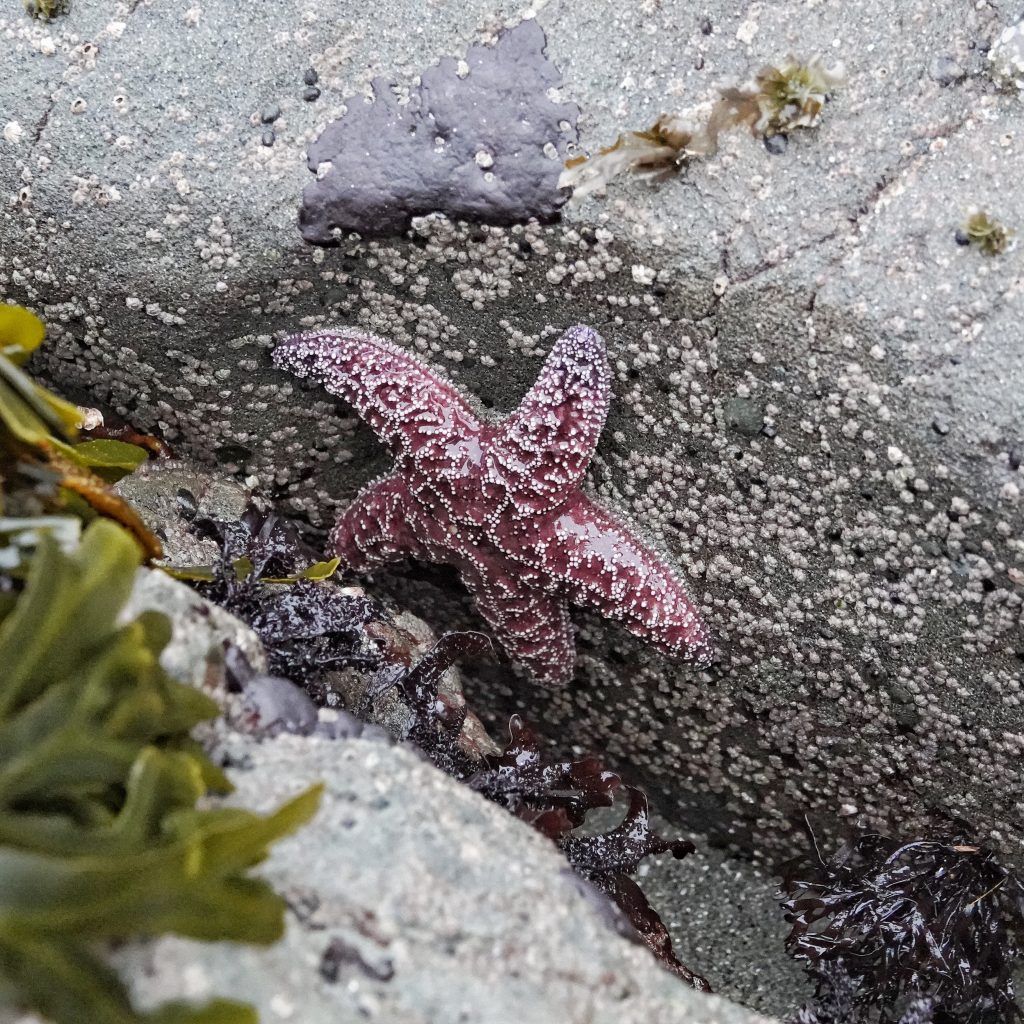
We took the Hobbit Trail near Yachats down to the beach last February. Some of the tidepools and the seeps of water from the cliffs were frozen over. I was surprised that these purple dudes were seemingly happy enough in those very cold conditions.
I really do hope their numbers continue to climb back up.
Both for the sake of my pleasure in seeing them, and for their role in the ecosystems they inhabit, I hope so too!